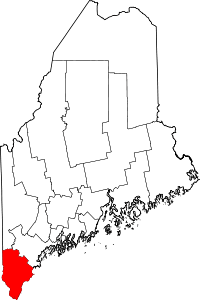Kennebunkport, Maine
Kennebunkport /ˌkɛnibʌnkˈpɔːrt/ is a town in York County, Maine, United States. The population was 3,474 people at the 2010 census.[4] It is part of the Portland–South Portland–Biddeford metropolitan statistical area.
Kennebunkport, Maine | |
|---|---|
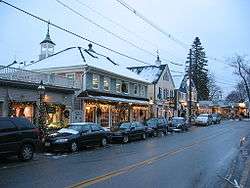 Downtown during the Christmas season, looking towards Dock Square | |
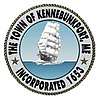 Seal | |
 Kennebunkport, Maine Location within the state of Maine | |
| Coordinates: 43°22′51″N 70°27′7″W | |
| Country | United States |
| State | Maine |
| County | York |
| Incorporated | July 5, 1653 |
| Government | |
| • Type | Town Meeting |
| • Town Manager | Laurie Smith |
| • Board of Selectmen | Patrick Briggs Shelia Matthews-Bull Stuart Barwise Edward Hutchins Allen Daggett |
| Area | |
| • Land | 18.6 sq mi (48 km2) |
| Elevation | 26 ft (8 m) |
| Population | |
| • Total | 3,474 |
| • Estimate (2019[3]) | 3,639 |
| • Density | 169.3/sq mi (65.4/km2) |
| Time zone | UTC-5 (Eastern (EST)) |
| • Summer (DST) | UTC-4 (EDT) |
| ZIP code | 04046 |
| Area code(s) | 207 |
| FIPS code | 23-36745 |
| GNIS feature ID | 0582540 |
| Website | www |
The town center, the area in and around Dock Square, is located along the Kennebunk River, approximately 1 mile (1.6 km) from the mouth of the river on the Atlantic Ocean. Historically a shipbuilding and fishing village, for well over a century the town has been a popular summer colony and seaside tourist destination. The Dock Square area has a district of souvenir shops, art galleries, schooner attractions, seafood restaurants, and bed and breakfasts. Cape Porpoise, while retaining its identity as a fishing harbor, has a very small village area with several restaurants, a church, grocery store, coffee shop, small library, and art gallery. Kennebunkport has a reputation as a summer haven for the upper class and is one of the wealthiest communities in the state of Maine. The Municipality of Kennebunkport includes the constituent villages of: Kennebunkport Village, Cape Arundel & Colony Beach, the Cottage Coast, Wilde’s District (Wildwood), Goose Rocks Beach, Turbatts Creek, Cape Porpoise Village, North Village Crossing (Townhouse Corner), among various other newer developments, as well as the enclave of Walker Point, which is the summer estate of the Presidential Bush Family.
Kennebunkport and neighboring towns Kennebunk and Arundel comprise school district RSU 21.[5]
History
Kennebunkport was first incorporated in 1653 as Cape Porpus, subject to the government of the Massachusetts Bay Colony (Maine was admitted to the Union in 1820 as part of the Missouri Compromise). Due to Indian depredations, the town was depopulated by 1689, and not resettled by Europeans again until the early 18th century. The town was renamed Arundel, and the town center located inland at Burbank Hill. In 1821 the town was renamed again, this time to Kennebunkport in reflection to its economy becoming one of shipbuilding and trade along the Kennebunk River.[6]
By the 1870s the town had developed as a popular summer destination, with both hotels and homes constructed along its coastline. Cape Arundel, Cape Porpoise, and Beachwood (now called Goose Rocks) were some of the early summer colonies; although Cape Porpoise was, and still is, a working fishing harbor. Since 1939, Kennebunkport has been home to the Seashore Trolley Museum.
The Great Fires of 1947, which devastated much of York County, affected Kennebunkport and especially the area near Goose Rocks Beach. Much of the housing near Goose Rocks Beach was destroyed by the fire, but the area has since recovered and been rebuilt.[7]
Geology
Like much of the northeast coast, the geography of the southern Maine coast was largely directed by the retreat of the Laurentide ice cap about 23,000 years ago.[8] The coast is framed by bedrock, left during the formation of the Appalachian mountains, and the irregular shape of the coast (characteristic of much of the New England coast, with the exception of Cape Cod and the islands) is attributed to differential erosion of the underlying rock layer.
The coast along Kennebunkport differs sharply from the Maine coast north and east of Portland due to differences in the composition of this rock layer. Beyond Portland, the layer is largely metamorphic rock, but here the coast is a mixture of igneous rock, and embayments of more deeply eroded sedimentary and metamorphic rock. These embayments result in the sandy beaches that can be found in southern Maine (such as Goose Rocks Beach, Colony Beach, and nearby Kennebunk Beach), but are uncommon north of Portland. Likewise the geology here differs from that of the outer lands (Cape Cod, Nantucket, and Martha's Vineyard in Massachusetts, Block Island in Rhode Island, and Long Island in New York), which were formed as terminal and recessional moraines, and do not contain much in the way of a bedrock skeleton.[9]
Geography
According to the United States Census Bureau, the town has a total area of 49.35 square miles (127.82 km2), of which, 20.52 square miles (53.15 km2) of it is land and 28.83 square miles (74.67 km2) is water.[1]
The town has several distinct areas, each developed during a phase of the town's history. The original town center was at Cape Porpoise, which today has a small village center, is both a summer colony and year-round community, and hosts a working fishing harbor. Inland from Cape Porpoise is a mix of forest and agricultural land, punctuated by an historic town center at Burbank Hill (there are a few historic buildings of interest here, including a schoolhouse and jail). Heading west towards the mouth of the Kennebunk river is Dock Square, the current town center.[10]
In the late 19th and early 20th century, Kennebunkport, and especially Cape Arundel (also known as Point Arundel), developed as a summer colony for the wealthy. Traveling from Dock Square along Ocean Avenue is the Cape Arundel Summer Colony Historic District.[11] This district of many well-preserved examples of early 20th-century shingle-style cottages begins at Chick's Creek and ends at Walker's Point.[12]
Adjacent municipalities
- Biddeford, Maine (north)
- Kennebunk, Maine (southwest)
- Arundel, Maine (west)
Rachel Carson National Wildlife Refuge
The Rachel Carson National Wildlife Refuge has a significant portion of lands in Kennebunkport northeast of Cape Porpoise and through Goose Rocks.[13] Within Kennebunkport, much of this protected land is salt-water marsh.
Climate
This climatic region is typified by large seasonal temperature differences, with warm to hot (and often humid) summers and cold (sometimes severely cold) winters. According to the Köppen Climate Classification system, Kennebunkport has a humid continental climate, abbreviated "Dfb" on climate maps.[14]
Summer home of the Bush family
Kennebunkport was also the summer home of former U.S. President George H. W. Bush, father of former U.S. President George W. Bush. First built by Bush's maternal grandfather George Herbert Walker, it has been a family home ever since, and has been owned by the Bush family since sometime in the early 1980s. The Bushes' ancestry is distinct from the Walker family that settled York County, Maine. Some of this family's Walker relatives are buried in the Kennebunkport area ancient cemeteries. During his presidency, George H.W. Bush often invited world leaders, from Margaret Thatcher to Mikhail Gorbachev, to Kennebunkport. In 2007, his son George W. Bush invited Vladimir Putin and Nicolas Sarkozy. The Bush compound is on Walkers Point, called Point Vesuvius prior to the Walker family's acquisition.
Demographics
| Historical population | |||
|---|---|---|---|
| Census | Pop. | %± | |
| 1830 | 2,763 | — | |
| 1840 | 2,768 | 0.2% | |
| 1850 | 2,706 | −2.2% | |
| 1860 | 2,668 | −1.4% | |
| 1870 | 2,372 | −11.1% | |
| 1880 | 2,405 | 1.4% | |
| 1890 | 2,196 | −8.7% | |
| 1900 | 2,123 | −3.3% | |
| 1910 | 2,130 | 0.3% | |
| 1920 | 1,431 | −32.8% | |
| 1930 | 1,284 | −10.3% | |
| 1940 | 1,448 | 12.8% | |
| 1950 | 1,522 | 5.1% | |
| 1960 | 1,851 | 21.6% | |
| 1970 | 2,160 | 16.7% | |
| 1980 | 2,952 | 36.7% | |
| 1990 | 3,356 | 13.7% | |
| 2000 | 3,720 | 10.8% | |
| 2010 | 3,474 | −6.6% | |
| Est. 2019 | 3,639 | [3] | 4.7% |
| U.S. Decennial Census[15] | |||
As of 2000 the median income for a household in the town was $54,219, and the median income for a family was $66,505. Males had a median income of $43,125 versus $34,028 for females. The per capita income for the town was $36,707. About 1.7% of families and 4.4% of the population were below the poverty line, including 4.4% of those under age 18 and 1.4% of those age 65 or over.
2010 census
As of the census[2] of 2010, there were 3,474 people, 1,578 households, and 1,039 families residing in the town. The population density was 169.3 inhabitants per square mile (65.4/km2). There were 2,897 housing units at an average density of 141.2 per square mile (54.5/km2). The racial makeup of the town was 99.0% White, 0.2% African American, 0.1% Native American, 0.7% Asian, 0.3% from other races, and 0.7% from two or more races. Hispanic or Latino of any race were 0.9% of the population.
There were 1,578 households of which 22.1% had children under the age of 18 living with them, 56.7% were married couples living together, 6.4% had a female householder with no husband present, 2.8% had a male householder with no wife present, and 34.2% were non-families. 28.6% of all households were made up of individuals and 13.1% had someone living alone who was 65 years of age or older. The average household size was 2.20 and the average family size was 2.68.
The median age in the town was 51.8 years. 17.9% of residents were under the age of 18; 5.6% were between the ages of 18 and 24; 15.2% were from 25 to 44; 36.5% were from 45 to 64; and 24.7% were 65 years of age or older. The gender makeup of the town was 47.5% male and 52.5% female.
Gallery
 South Congregational Church
South Congregational Church The harbor
The harbor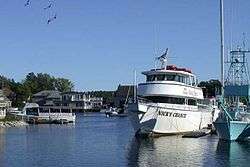 Boats on the Kennebunk River
Boats on the Kennebunk River Businesses on Ocean Avenue
Businesses on Ocean Avenue View of Dock Square
View of Dock Square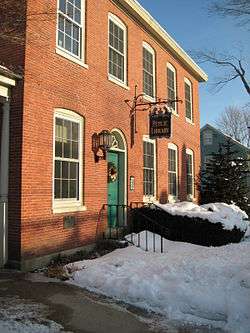 Louis T. Graves Memorial Public Library
Louis T. Graves Memorial Public Library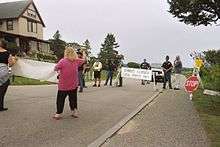 Protestors on Ocean Ave. near the Bush Compound, in 2008
Protestors on Ocean Ave. near the Bush Compound, in 2008
Notable people
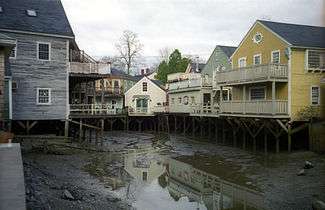
- Margaret Deland, novelist
- Patrick Dempsey, actor
- Dan Goodwin, building, rock, and sports climber
- Frank Handlen, painter
- Garnet Hathaway, professional ice hockey player
- Joshua Herrick, US congressman
- Dick McCabe, racing driver and champion
- Wiley Miller, cartoonist
- Jane Morgan, singer, actress
- Russell Nype, actor
- Shiloh Pepin, Sirenomelia patient with legs fused
- George Clement Perkins, 14th governor of California
- Kenneth Roberts, author
- Rex Smith, American singer and actor
- Booth Tarkington, novelist and dramatist
- George Herbert Walker, banker, businessman, grandfather of US President George H. W. Bush, and great-grandfather of George W. Bush
- Bentley Warren, racecar driver
- Neil Clark Warren, online dating service chairman
Film appearances
Kennebunkport was featured in the 2003 filming of the film Empire Falls by Maine author Richard Russo, with a downtown book shop making a notable appearance. The film starred actors including Robin Wright, Paul Newman, Joanne Woodward, Helen Hunt, Ed Harris and Estelle Parsons. Only Wright appeared on set in Kennebunkport.[16]
Other films with scenes filmed in Kennebunkport include Lost Boundaries (1949), [My Husband's Double Life] (2003), The Man Who Knew Bush (2004 Documentary), The Living Wake (2007), 41 (2012 Documentary) and US Route 1-ME (2012).[17]
References
- "US Gazetteer files 2010". United States Census Bureau. Archived from the original on 2012-12-20. Retrieved 2012-12-16.
- "U.S. Census website". United States Census Bureau. Retrieved 2012-12-16.
- "Population and Housing Unit Estimates". Retrieved May 21, 2020.
- "Geographic Identifiers: 2010 Demographic Profile Data (G001): Kennebunkport town, York County, Maine". U.S. Census Bureau, American Factfinder. Archived from the original on February 12, 2020. Retrieved January 29, 2013.
- http://www.rsu21.net/facilities/ Maine Regional School unit 21 ARUNDEL|KENNEBUNK|KENNEBUNKPORT Facilities
- Coolidge, Austin J.; John B. Mansfield (1859). A History and Description of New England. Boston, Massachusetts: A.J. Coolidge. pp. 176–181.
coolidge mansfield history description new england 1859.
- Archived July 7, 2010, at the Wayback Machine
- "North Atlantic Coast Ecoregion // LandScope America". Landscope.org. Retrieved 2013-01-10.
- Kelley, Joseph T. "Coastal Bluffs of New England" (PDF). gulfofmaine.org. Retrieved 2013-01-10.
- Archived May 18, 2009, at the Wayback Machine
- "Maine Historic Preservation Commission: National Register of Historic Places: Historic Properties: Historic District List". State.me.us. Retrieved 2013-01-10.
- "National Register of Historic Places". mykennebunks.com. Retrieved 2013-01-10.
- Carson, Rachel. "National Wildlife Refuge" (PDF). United States Fish and Wildlife Service. Retrieved 2013-01-10.
- Climate Summary for Kennebunkport, Maine
- "Census of Population and Housing". Census.gov. Retrieved June 4, 2015.
- http://www.bookweb.org/news/hbos-empire-falls-transforms-kennebunk-book-port
- https://www.imdb.com/search/title?locations=Kennebunkport%2C%20Maine%2C%20USA&ref_=ttloc_loc_2
External links
| Wikimedia Commons has media related to Kennebunkport, Maine. |
| Wikivoyage has a travel guide for Kennebunkport. |
